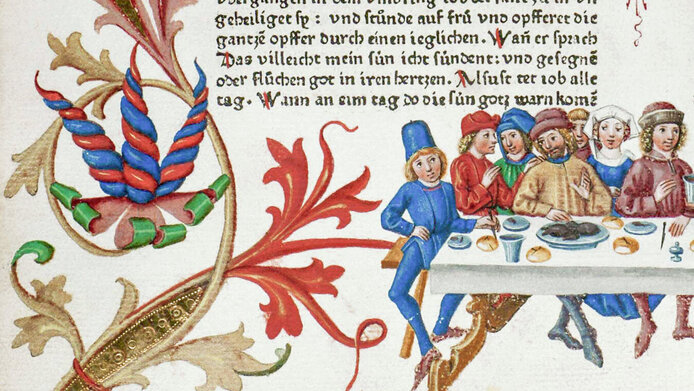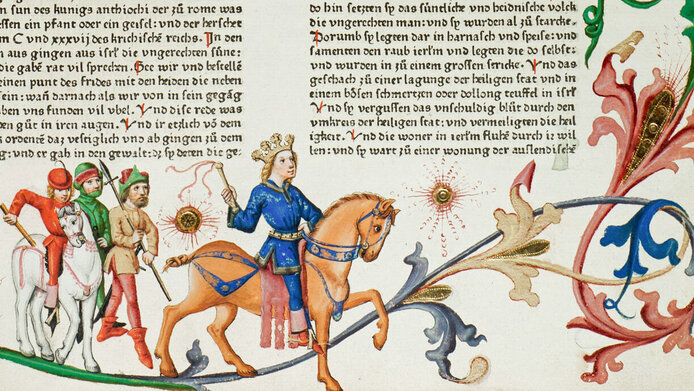The colourful world of early printed works

“Some of the images and ornaments look as if they were painted only yesterday” says Michael Viktor Schwarz, Professor of Art History at the University of Vienna, visibly gripped by enthusiasm when talking about book illuminations. Unlike monumental or panel paintings, which are usually poorly preserved, book illumination conveys an experience of freshness, Schwarz notes. Painted on almost indestructible paper and protected by the book pages surrounding them, the images have in many cases survived undamaged to this day. “When you open incunabula, you often feel the last 500 years never happened.”
“Incunabula” are books from the early days of printing, or, more precisely, from the early days of printing with movable type in Europe. Book printing originated in the middle of the 15th century. 1454, the year which saw the publication of the Gutenberg Bible, is usually considered as the starting point, and an incunabulum is a work printed before the year 1500. The term thus refers to printed products from just less than 50 years of human history at the transition from the late Middle Ages to the Renaissance, which was a highly dynamic period in intellectual terms.
Focus on illuminated incunabula
The Austrian National Library (ÖNB) houses one of the most important collections of incunabula in the world. “The collection is very large and diverse, but also manageable in terms of provenance,” says Schwarz, “its holdings can be considered representative of the German-speaking area.” Between late 2016 and May 2020, researchers from the University of Vienna and the Austrian National Library, including Schwarz, were involved in an FWF-funded project concerning an important part of the collection: the illuminated incunabula. Around 20 percent of the incunabula in the ÖNB are decorated with painted illustrations called illuminations.
The scholars’ main goal was to produce a catalogue of the illuminated incunabula from the last quarter of the 15th century according to art history criteria. “Cataloguing and describing involves first and foremost dating and locating,” says Schwarz, who notes that the date and location of the printing is usually clear. “We use the tools of art history to determine when and where the illuminations were done and who the artists were – and, sometimes, who had commissioned them.”
The beginnings of the book industry
These “tools of art history” refer to a critical analysis of stylistic elements, in other words cataloguing paintings according to established schemes and identified styles. Catalogues established on the basis of art history not only help in dating a work or providing answers to issues of art history. They also enable scholars to draw conclusions about the changing social and economic conditions – namely the emergence of a publishing sector. In this way, research provides an insight into the incipient mass production of books and the emergence of an early “book industry”.
While monasteries themselves often decorated prints they purchased with illuminations, the bulk of late 15th-century output was produced by commercial workshops that had some form of collaboration with the printers and booksellers. In some infrequent cases, individual names and biographies of employees of such workshops are known. “In Augsburg, a Johannes Bämler was engaged in this work for many decades. He started out as a professional scribe before the time of printing and later became both a printer and illuminator,” notes Schwarz. “In Austria, we know Ulrich Schreier, who worked first in Salzburg and then in Vienna, colouring both handwritten and printed books.” Schwarz adds that Schreier was also a bookbinder and produced a number of highly original book covers. The illuminations and an artfully designed cover turned books into luxury items.
Book printing fuels book illumination
The quantity and quality of the painted decorations found in the incunabula came as a surprise, including to the researchers involved in the project. “There was a common notion that the invention of printing heralded the end of book illumination,” says Schwarz, conceding that this was actually true over the long term. “But in the 15th century, printing initially acted as a great promotion for illumination.” The advent of letterpress printing redefined the entire world of books. The technology lowered production costs considerably, resulting in many more books being produced. Major centres of book printing and the book trade evolved in the German-speaking world, and subsequently, supra-regional book markets developed. “The upsurge in book production resulted in an increased demand for book illumination – in Leipzig, for instance, which turned into a city of books, of book production, the book trade and book illumination.” Accordingly, the project placed the focus on the German centres of the book trade that had the greatest relevance for the Austrian region: Leipzig, Nuremberg and Augsburg.
According to Schwarz, it is impressive to see the extent to which book illumination was a token of the great appreciation people had for books and their contents. It shows that mass production did not diminish the value of the book. “While it is true that printing led to a flood of books being produced, the contributions of the illuminators clearly show that this did not result in books losing value in the eyes of contemporaries.” The individual book was still a precious object, created more or less for eternity. That, Schwarz says, was another culturally interesting aspect of book illumination. “Today we would probably put it like this: books were sustainable items.”
Personal details
Michael Viktor Schwarz received his doctorate from the University of Mainz in 1983. After an extended stay at the Bibliotheca Hertziana in Rome, he acquired his professorial qualification in Freiburg in 1991 and was appointed to a professorship at the University of Vienna in 1998. Following positions as Head of the Department of Art History and Dean of the Faculty of Historical and Cultural Studies, he was appointed Chairman of the Senate of the University of Vienna in 2015.
An expert on medieval art, Schwarz focuses his research on book illumination and on visual media in Christianity. The research project “Illuminated Incunabula in the Austrian National Library. Central European Schools (ca. 1475-1500)” received EUR 398,000 in funding from the Austrian Science Fund FWF with 398,000 euros. The resulting volumes of the catalogue with its critical art-history approach will be published by the Austrian Academy of Sciences in 2022.
More information
Project website Illuminated Incunabula






